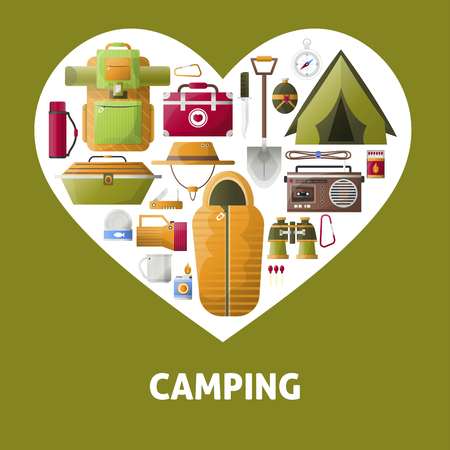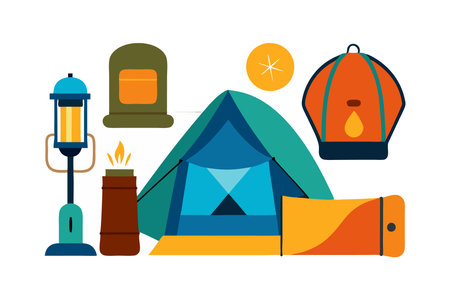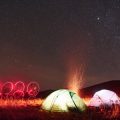1. Pre-Trip Planning: Know What You Need
Before you start packing your camping gear, it’s important to know exactly what you’ll need for the trip. This step sets the foundation for a smooth setup and breakdown at your campsite. Begin by understanding three key things: where youre going, what the weather will be like, and how long youll be out there.
Understand Your Destination
Are you heading to a mountain campground, a beach site, or a forested area? Each environment has its own set of needs. For example, coastal campsites may require extra tarps or wind protection, while high-altitude areas might call for warmer sleeping bags. Research your location ahead of time to avoid surprises.
Check the Weather Forecast
Weather can make or break your camping experience. Always check the forecast for the days you’ll be out and pack accordingly. If rain is expected, bring waterproof gear and extra dry clothes. If it’s going to be hot, make sure you have enough shade options and hydration supplies.
Plan Based on Trip Duration
The length of your trip will affect how much food, water, fuel, and clothing you need. A weekend getaway requires much less than a week-long backcountry adventure. Don’t just guess—make a checklist that fits the actual number of days youll be gone.
Sample Gear Checklist Based on Trip Details
| Item Category | Short Trip (1–2 Days) | Long Trip (3+ Days) |
|---|---|---|
| Shelter | Tent, Ground Tarp | Tent, Ground Tarp, Extra Stakes |
| Bedding | Sleeping Bag, Pad | Sleeping Bag (Warmer), Pad, Pillow |
| Clothing | 1 Change of Clothes | Multiple Layers, Rain Gear |
| Food & Cooking | Snacks, One-Pot Meals | Meal Plan, Cooler, Camp Stove |
| Lighting | Headlamp or Flashlight | Lamp, Extra Batteries |
| First Aid & Safety | Basic Kit | Full Kit with Medications |
Avoid Overpacking
A big part of organizing your gear is making sure you don’t bring too much. Every extra item adds weight and takes up space. Stick to essentials based on your checklist and resist the urge to pack “just in case” items unless they serve a clear purpose.
2. Gear Categorization: Grouping by Function
One of the easiest ways to streamline your camping setup and breakdown is to organize your gear by function. Instead of tossing everything into one big bin or bag, group your items based on how you’ll use them at camp. This method not only saves time but also helps you find things quickly when you need them.
Why Functional Grouping Works
When your gear is organized into categories like cooking, sleeping, shelter, and personal items, you don’t have to dig through unrelated stuff to find what you need. It also makes it easier to delegate setup tasks to different people in your group—one person can handle the kitchen setup while another takes care of the tent.
Common Gear Categories
Here’s a basic breakdown of functional groups most campers use:
| Category | Examples of Items |
|---|---|
| Cooking | Stove, fuel, pots, pans, utensils, cutting board, dish soap, sponge, trash bags |
| Sleeping | Tent, sleeping bag, sleeping pad or air mattress, pillow, extra blankets |
| Shelter | Tarp, canopy, tent stakes, mallet, guy lines |
| Personal Items | Clothing, toiletries, medications, flashlight/headlamp, sunscreen, bug spray |
Pro Tip:
Use labeled bins or color-coded dry bags for each category. For example, keep all your kitchen gear in a blue bin and your sleep system in a green duffel. This visual cue helps you stay organized even after multiple trips.
Packing for Efficiency
If space allows, pack each category into its own container or bag and load them into your vehicle in reverse order of use. That means the last thing youll set up (like sleeping gear) goes in first so it comes out last. Cooking and shelter items should be easily accessible for quick setup when you arrive at camp.
A Sample Packing Order:
- Shelter gear near the top or rear door of your car for fast access
- Cooking gear next so you can get meals going quickly if needed
- Sleeping bags and pads further back since theyre usually set up last
- Personal bags and extras tucked around the larger bins
This kind of organization turns chaos into calm at the campsite—and gets you relaxing by the fire that much faster.

3. Smart Packing Techniques for Your Vehicle
Packing your vehicle the right way can make a huge difference when it comes to setting up camp quickly and tearing down just as fast. With a little strategy and the right containers, you’ll spend less time digging through gear and more time enjoying the outdoors.
Use Bins, Crates, and Duffel Bags
To keep things organized, use stackable plastic bins for rigid items, milk crates for odd-shaped essentials, and duffel bags for soft gear like clothes or sleeping bags. Label each container so you know exactly whats inside without having to open everything at once.
Container Type Breakdown
| Container Type | Best For | Pros |
|---|---|---|
| Plastic Bins | Cooking gear, tools, lighting | Stackable, weather-resistant |
| Milk Crates | Water bottles, firewood, misc. items | Easy to carry, ventilated |
| Duffel Bags | Clothing, bedding, towels | Flexible shape, fits in tight spots |
Pack in Reverse Order of Use
The key to a smooth setup is packing with purpose. Put the last items you’ll need at the bottom or back of your vehicle and the first items—like your tent, tarp, or camp chairs—right near the door or on top. This way you don’t have to unload everything just to get started.
Example Packing Order (Back to Front)
- Back of the Car: Food cooler, extra clothes, games/toys
- Middle: Cooking gear, kitchen bin, water jugs
- Front/Top: Tent, ground tarp, camp chairs
This system not only speeds up your setup but also helps prevent losing track of important items when youre ready to pack up and head home.
4. Quick-Access Essentials: What to Keep Handy
When you roll up to your campsite, the last thing you want is to dig through bags and bins just to find your flashlight or bug spray. Thats why its smart to pack a separate “quick-access” kit with the essentials youll need right away. This strategy saves time and helps you get set up faster—especially if youre arriving late in the day or in bad weather.
Why Quick-Access Matters
The first 15–30 minutes after arrival are crucial. You’ll likely want to:
- Mark your spot and check surroundings
- Set up shelter before it gets dark
- Keep bugs off while working
- Grab a snack or water quickly
Packing these items where they’re easy to grab can make all the difference.
Must-Have Items for Immediate Access
| Item | Why You Need It Right Away | Packing Tip |
|---|---|---|
| Headlamp or Flashlight | You might arrive near dusk or lose daylight quickly | Keep one in the glove box or backpack side pocket |
| Tent & Ground Tarp | Your first priority is getting shelter up | Pack them on top of other gear or in a separate bag |
| Bug Spray | Bugs can be fierce at certain times of day or year | Store in an outer mesh pocket of your pack or a car door compartment |
| Sunscreen | If it’s sunny, you’ll want protection from the start | Tuck it into your quick-access kit or daypack |
| Water Bottle or Hydration Pack | You’ll need hydration after travel and during setup | Keep it within arm’s reach in the car or top of your bag |
| Pocket Knife or Multi-Tool | You may need to cut rope, open packaging, etc. | Cinch it to your belt loop or keep in an outer pouch |
Create a Quick-Access Kit
An easy way to stay organized is by dedicating a small duffel bag, clear plastic bin, or even a sturdy tote as your “first-out” gear container. Think of it as your camping carry-on—what you’d bring if you could only grab one thing.
Packing Tips:
- Add reflective tape to this kit so you can find it easily at night.
- If traveling with others, let everyone know where this kit is packed.
- If possible, place this bag near the back door of your vehicle for fast access when unloading.
A little planning goes a long way. With your quick-access essentials ready to go, you’ll hit the ground running and be roasting marshmallows before you know it.
5. Streamlined Setup and Breakdown Strategies
Setting up and breaking down camp doesn’t have to be a hassle every time you head out. With the right packing strategies and a little bit of practice, you can turn these tasks into smooth, quick routines that get you in and out of camp with less stress.
Stick to a Routine
The key to efficiency is repetition. Follow the same steps each time you set up or tear down your campsite. This helps everyone know what to expect and makes it easier to remember what goes where. For example, always start with setting up the tent, then organize sleeping gear, followed by kitchen setup. When packing up, reverse the order.
Assign Roles for Your Crew
If youre camping with family or friends, assign tasks so everyone has a job. Not only does this speed things up, but it also keeps people from stepping on each other’s toes during busy moments.
Sample Task Assignment Table
| Person | Setup Task | Breakdown Task |
|---|---|---|
| You | Tent assembly & layout gear | Packing tent & checking for forgotten items |
| Partner | Kitchens setup (stove, table) | Cleaning & packing cooking gear |
| Kid #1 | Laying out sleeping bags & pads | Rolling up sleeping gear |
| Kid #2 | Collecting firewood / setting chairs | Packing chairs & trash collection |
Repack Items in the Same Order Every Time
This might seem like a small detail, but putting your gear back in your bins or duffels in the same order every trip can save tons of time. When you arrive at your next campsite, you’ll know exactly where everything is without digging through bags.
Packing Sequence Example:
- Tent and shelter items on top (used first)
- Sleeping gear second (pads, bags, pillows)
- Cooking supplies and food containers next
- Campfire accessories and extras on bottom (used last)
Create a Camp Setup Checklist
A checklist helps keep everyone on track and ensures nothing gets left behind or overlooked. Print one out or keep it on your phone so it’s easy to reference during setup and breakdown.
This system not only saves time—it also helps avoid those frustrating “where did we put the stove?” moments. Over time, your crew will move like a well-oiled machine!


